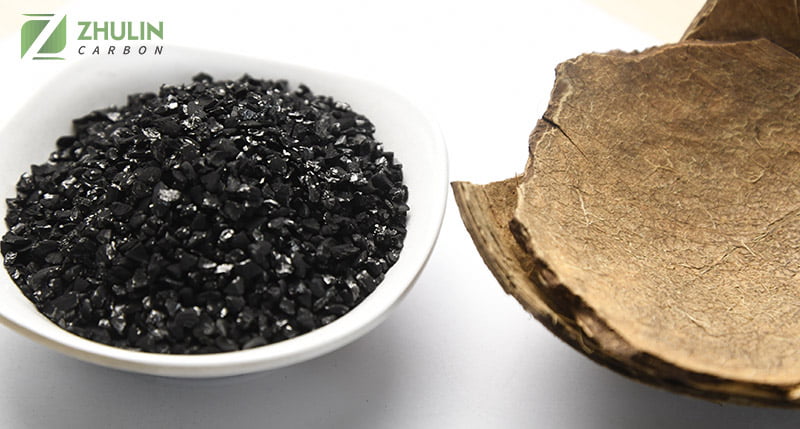
You may have heard of activated carbon coconut shell, but do you truly learn about this form of activated carbon?
If you wish to delve further into the understanding of coconut activated carbon, you can explore this article.
Our article will discuss various uses and advantages of coconut shell activated carbon, as well as the manufacturing process of coconut shell charcoal.
Hint: Please note that you can click below for quick reads on topics that interest you:
What is coconut shell activated carbon?
Activated coconut carbon is a primary type of activated carbon with highly porous, high hardness, and filtration performance characteristics.
Through appropriate processing and carbonization, coconut shells can be prepared into activated carbon with adsorption capabilities and other special properties.
As you know, coconut based activated carbon is widely used in various fields.
Due to coconut shells being a natural renewable resource, coconut shell charcoal is also considered a relatively environmentally friendly choice.
Its porous structure enables efficient adsorption of organic substances, gases, and impurities dissolved in water, making it widely applied in environmental and industrial applications.
How is activated carbon made from coconut shells?
It is well known that the raw material for coconut shell charcoal comes from coconut shells.
The production manufacturing of coconut shell charcoal involves the collection and processing of raw materials, grinding and crushing, carbonization, activation, washing and drying, sieving, and packaging.
In the following flowchart, you can clearly see how to make activated carbon from coconut shells.

Step 1: Collection and Processing
Collect coconut shells as raw materials from coconuts.
Coconut shells, the outer hard shell of coconuts, can be obtained from agricultural industries or coconut processing plants.
Step 2: Grinding and Crushing
Preliminary grinding and crushing of coconut shells reduce particle size, making them more easily processable.

Step 3: Carbonization
Heat coconut shells in an inert atmosphere, such as flue gas, according to pre-determined dimensions for carbonization.
During this process, carbon undergoes dehydration and devolatilization, reducing the volatile content of coconut shells to below 20%.
Step 4: Activation
Proceed to the activation stage to enlarge the pore structure, increase internal surface area, and make it more accessible.
Steam activation is employed at temperatures ranging from 900°C to 1100°C, and chemical reactions between carbon and steam occur on the internal surface of the carbon.
The steam activation process can easily modify pore sizes and produce carbon tailored for specific final applications.

What are the uses of coconut activated carbon?
Precious Metal Recovery
Due to its high wear resistance and excellent chemical and physical properties, coconut shell charcoal is essential for applications such as the recovery of gold and other precious metals.
It serves as an adsorbent in metal smelting and extraction processes, assisting in the removal of metal ions.
Drinking Water
Coconut shell activated carbon is widely used in water treatment to eliminate color, odors, taste, organic compounds, heavy metals, and other pollutants in drinking water.
With its pore structure predominantly composed of micropores (over 80%), coconut based activated carbon efficiently adsorbs impurities with a microporous molecular structure.
Nowadays, it has become one of the preferred forms of activated carbon for water filtration and purification.
Therefore, coconut shell charcoal filters have become the optimal choice for purifying drinking water.
Removal of Organic Impurities in the Food and Beverage Industry
Coconut shell activated carbon is employed as a decolorizing agent in the food and beverage industry to remove color, odors, and undesirable tastes.
Catalyst Support
Due to its superior chemical and physical characteristics, coconut shell charcoal, as a solid material with high surface area and chemical stability, is commonly used as a support for catalysts.
Medical Devices
In the field of medical devices, the high adsorption capacity of coconut shell charcoal is utilized to adsorb toxins, alleviating symptoms.
Wastewater Treatment
Coconut shell charcoal finds extensive use in wastewater treatment, primarily through adsorption and physicochemical processes to remove organic matters, heavy metals, decolorization, deodorization, pH adjustment, and microbial inhibition.
Do you plan to purchase activated carbon?
What are the properties of coconut shell activated carbon?
Conclusion
Therefore, you now have a further understanding of coconut shell charcoal.
Many people often inquire whether coconut shell charcoal is better than traditional activated carbon, and the answer is evident—it is indeed superior.
As you know, activated carbon coconut shell has a multitude of applications across various industries. Activated carbon made from coconut shells is of high quality, efficient, and environmentally friendly.
Additionally, coconut shell charcoal itself possesses numerous advantages and benefits.
With 20 years of experience in activated carbon manufacturing, you can find the activated carbon that you need here.
Do you plan to purchase activated carbon?